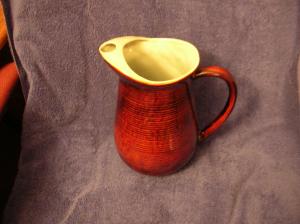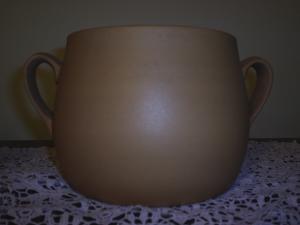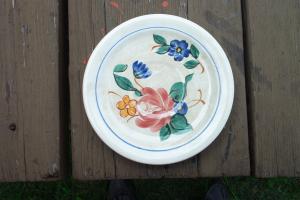Question:
 I have a large brown pitcher with light green inside. Its about 10" tall, stamped on the bottom Red Wing USA. This was my Mother’s, can you tell me any thing about it. Thanks Rich
I have a large brown pitcher with light green inside. Its about 10" tall, stamped on the bottom Red Wing USA. This was my Mother’s, can you tell me any thing about it. Thanks Rich
Category Archives: Dinnerware
Provincial Bakeware Bean Pot
Question:
 Hello, This piece is rough textured on the outside and orange glazed on the inside. It’s stamped Red Wing USA 405. Could you tell me about the piece and it’s value. It is five and one half inches tall and about 22-23" around. Thank-You.
Hello, This piece is rough textured on the outside and orange glazed on the inside. It’s stamped Red Wing USA 405. Could you tell me about the piece and it’s value. It is five and one half inches tall and about 22-23" around. Thank-You.
Red Wing Dinnerware: Orleans
Question:
 Hi, a mother of a friend of mine has this pattern. (Orleans?) She has the complete place setting for 12. Also gravy boat,pitcher, bowls, etc. I know it is difficult to answer without all the details of the pieces,(There are more pieces)but it is up in thier attic where it has been since the 60′s. She remembers using them for special occasions in the 50′s. A friend gave her mother the COMPLETE set. As far as she knows, none are broken. there was no crazing on the piece she gave me to photograph. If the set is complete, what is it’s approx value? Thank you!
Hi, a mother of a friend of mine has this pattern. (Orleans?) She has the complete place setting for 12. Also gravy boat,pitcher, bowls, etc. I know it is difficult to answer without all the details of the pieces,(There are more pieces)but it is up in thier attic where it has been since the 60′s. She remembers using them for special occasions in the 50′s. A friend gave her mother the COMPLETE set. As far as she knows, none are broken. there was no crazing on the piece she gave me to photograph. If the set is complete, what is it’s approx value? Thank you!
Continue reading
Bob White Pitcher 14 inch
I have a 14 inch Bob White pitcher in perfect condition. I was curious about the value and if you know of any specific places that might be interested in purchasing it. Thanks LuAnn P.
Answer:
The 14 inch (or 112 oz) Bob White pitcher seems to vary considerably in value, depending on the knowledge of the buyer and seller. I’ve seen them sell for as little as $25 and as much as $200. I would place the value for such a pitcher in excellent condition to be somewhere in the middle, in the range of $75 to $125. While far less common than the ubiquitous 60 oz pitcher, the 112 oz pitcher certainly isn’t rare and is often seen on eBay.
PROVINCIALWARE 25
Hello, I recently purchased a red wing piece that I haven’t heard of. Have you ever heard of Red Wing Provincial Ware? It is an impressed stoneware pan – the measurements are: 7 1/4" long base, 9" long mouth, 2 3/8" tall. "REDWING PROVINCIALWARE 25" is impressed clearly on one side. It has a mottled finish with some age checkering. It is in excellent condition. I have looked through all my books, and have not been able to find any information on this piece. I have been collecting red wing for about 4-5 years. Mainly started out with larger size crocks. I have gotten more serious in the pieces I now collect. I also own a 1/2 gallon salt glaze North Star jug, in mint condition. I really appreciate your time in helping me. I printed out a membership application tonight, and will be mailing it in right away. I didn’t know if I needed to be a member before asking any questions on this site. Once again, thank you so much for your
time. Candi L.
Answer:
Candi, Welcome to the RWCS! Always good to hear from our new members. Your Red Wing Provincial Cooking Ware piece dates to the World War II era. Metals were in short supply for consumers during the war years, and Red Wing offered Provincial Cooking Ware to fill the void. The line consists of casseroles in several sizes, bean pots, stock pot, shallow cooking dishes and a frying pan. The exteriors were bisque (unglazed) and tan in color while the interiors and covers had a rust colored glaze. As you noted, the exterior sides of these pieces was stamped "Red Wing Provincial Ware" along with the stock number of the item. I believe you have the frying pan.
This line is not popular with collectors today for a couple of reasons. The bisque clay absorbed grease and soil during use; most pieces found today look dirty and don’t clean up well. Occasionally a vintage unused piece turns up and the colors are quite striking. Such a piece would have more value than the usual dirty-looking pieces. This line included only cooking pieces — no plates, bowls, cups or other serving pieces that collectors prefer.
In the 1960s Red Wing re-introduced this line with several changes from the original 1940s cook ware line. A tan glaze covered the exterior to help keep them clean. The cooking pieces were marked Red Wing USA on the bottom rather than markings on the side. And serving pieces (plates, bowls, cups, sugar & creamer, etc) were available to go with the cook ware. Serving pieces are rust colored and are in the Village Green shape.
Larry
Falconer Canisters
I recently purchased a set of four (4) canisters at an auction. I have tried to look up the pattern and the value on the web and keep coming up empty handed. I have all four canisters with all the lids, and they are in mint condition. They are all stamped on the bottom with "Red Wing Falconer Stoneware" not sure about the Falconer part but it looks like that on all the pieces. Could you please tell me the pattern and the approx. value? Thanks Sara
Answer:
Sara, Your canisters were not made by Red Wing Potteries. They were made by Falconer Stoneware of Red Wing, Minnesota. This new company originated in the mid to late 1980s and has no connection to the original Red Wing potteries. In the early 1990s the name of this company changed from Falconer Stoneware to Red Wing Stoneware Company; the company mark used on their products also changed at this time. Thus your Falconer Stoneware canister set is 15 to 20 years old. I don’t know the pattern name or what current values might be for this set. Thanks Larry
Hotel China
I have a few Red Wing dishes I picked up at an antique store. Can you tell me what year they were made in. I love Red Wing pottery and was just curious about the history and what their value might be, they are plain but beautiful and make a wonderful addition to my dinnerware. Thanks Jeanie
Answer:
Jeanie,
Your photo shows a white piece from Red Wing’s Hotel or Restaurant China line. This was a line of sturdy dinnerware sold to restaurants, not to the general public. Because it was made for restaurant use rather than for the home, the pieces available are somewhat different than those available in most dinnerware patterns. Pitcher, salt & pepper shakers, casserole, butter dish, gravy boat and vegetable bowl are among the "standard" dinnerware accessories not made in the Hotel or Restaurant line. But the line did include restaurant-oriented pieces such as the lobster dish, pot pie bowl, bouillon cup, ash tray and individual teapot.
Standard colors in Hotel & Restaurant China were white or beige fleck. Colored trim lines around the edges could be added for an additional charge. I’ve seen these in green, yellow, red and blue. A customer could also order custom artwork to be hand painted on their dishes, and at least two restaurants did so. Sweden House plates show a home (probably a Swedish home) along with frills in shades of blue, while Diamond Jim’s plates have old-time automobiles in black, red and pink. A couple of plates made for the Thunderbird Motel have also surfaced; due to the small number these were probably samples rather than production pieces.
Hotel or Restaurant China was introduced in the early to mid-1960s. Dates are uncertain because the line was not sold to the general public and thus is not included in dealer price lists. Values for most of the undecorated white or beige fleck pieces are rather low, in the $5 to $10 range for standard plates and bowls. Unusual pieces such as the lobster dish are more valuable — $25 to $40. The lobster dish is the only piece that was available in orange, and an orange lobster dish would be worth more than white or beige fleck. Teapots ($20-$40), creamers & sugars ($20-$30), and cups & saucers ($15-$25) have some additional value because some collectors seek one from each Red Wing pattern.
Larry
Crocus Pattern
Hi. I have several pieces of a pattern that is from either 1960 or 1961. It is white, with green and lavender (), and I believe the pattern name is lotus blossom (I could be wrong, I can’t remember). I am considering selling them, and I’m wondering what to ask. I have a very large salad bowl, what looks like a vegetable or relish tray with fitted bowls, dinner plates, etc. Hopefully, this is enough information to get my question answered. Thanks Mary M.
Answer:
Mary,
From your description I believe you have items from the Crocus pattern, one of the patterns in the True China line. Crocus apparently did not sell well and is difficult to find today. True China patterns were introduced in 1960. Crocus appears in the 1961 and 1962 price lists. I don’t have a 1963 price list but I suspect Crocus was not included. I am not aware of any collectors of the Crocus pattern but no doubt they exist. There are also collectors who seek one of a certain item from each Red Wing pattern such as a teapot, a S&P shaker set, a cup & saucer, etc. These collectors are eager to find Crocus pieces in their specialty.
Your description refers to a relish dish with fitted trays. This is the 6-piece relish, a piece made only in the six True China patterns. If yours is complete and in excellent condition, it is worth at least $200 and perhaps considerably more to the right collector. Crocus teapots and beverage servers are also highly prized and worth at least $200. I’m not aware of people who collect large salad bowls but yours would certainly be of interest to anybody building a set of Crocus; the value should be around $50. Dinner plates are sought by dinner plate collectors and are worth $25 to $50. All values assume excellent condition.
Larry
Friar Tuck – irregular border
Why does my Friar cookie jar have a one inch irregular brown border on the bottom? Thanks Phyllis B.
Answer:
Without a photo it’s impossible for me to be sure about brown border on your cookie jar. My best guess is that the "border" is cookie grease that has seeped into the jar. This is a rather common problem with Friar Tuck, Katrina and Chef Pierre cookie jars that have seen a lot of use. As cookies set at the bottom of the jar, the oil in them tends to move through tiny cracks in the glaze (crazing) and into the clay under the glaze. When the clay gets saturated with oil it has a dirty brown appearance.
Larry
Blossom Time Service
I am looking for any information regarding the Red Wing dishes
that belonged to my grandmother. I have a complete service for 8 including
casserole and serving dishes. Since I know nothing about the dishes I have
attached a photo.
I also have a complete service for 8 including casserole and serving
dishes in the Lotus Concord 1941 pattern and would like information about
this dish set.
Thank you for you help.
Monica S.
Answer:
Monica,
The pattern in the plate in your photo is Blossom Time. Lotus and Blossom Time are both patterns in the Concord shape, which was first produced in 1941 in the Harvest and Lexington patterns. Lotus was introduced in 1947 and made until 1957. Blossom Time was introduced late 1949 or early 1950 and discontinued in 1955.
"Complete set" does not provide sufficient information to price a set. The term means different things to different people, and does not define which accessory pieces are included in the set. Condition of the pieces is also a critical factor in determining value. Lotus and Blossom Time are comparable in value. Dinner plates are worth $10 to $15, salad and bread plates $5 to $10, teacups & saucers $10 to $15, small bowls $5 to $10. Casseroles are worth around $25. All prices are retail and assume excellent condition.
Larry
